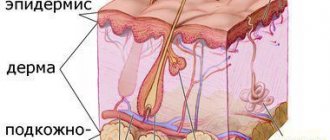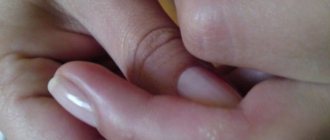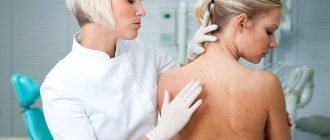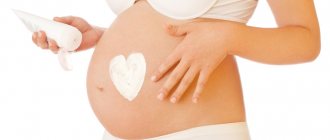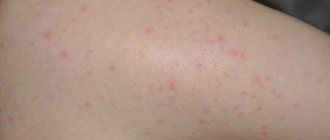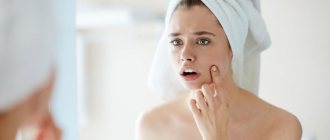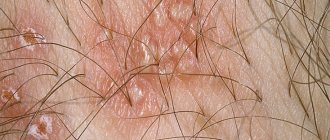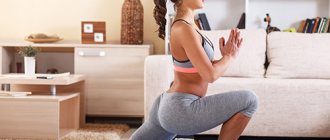External causes of acne on the back
External causes of subcutaneous acne on the back are associated with the influence of environmental factors. In particular, external causes of acne on the back include:
- use of inappropriate cosmetics;
- insufficient hygiene (rare washing) of the back;
- wearing synthetic and too tight clothing, which absorbs sweat and dirt.
External causes of back acne also include loose hair, the ends of which irritate the skin, causing excess sebum production. Sunbathing without protective equipment can also cause acne. After all, under the influence of sunlight, the stratum corneum of the epidermis thickens, which leads to the accumulation of sebum and clogging of pores.
The causative agent of the boil
The formation of a boil is mainly due to the penetration of Staphylococcus aureus into the hair follicle. These bacteria can normally be found on the skin and are not dangerous. However, when introduced into the hair follicle, an inflammatory process begins.
The disease begins to develop with reduced immune activity. When the immune system is unable to fully prevent the spread and growth of pathogenic microorganisms, they begin to rapidly multiply and penetrate the pores. This leads to deterioration of the skin microflora and the formation of abscesses.
Internal causes of acne on the back
Internal causes of acne on the back are associated with the functioning of the body. Among the internal causes of rashes:
- allergy;
- genetic predisposition;
- diseases of the gastrointestinal tract;
- overweight;
- poor nutrition;
- stress;
- excessive sweating;
- endocrine disorders.
In addition, internal causes of acne on the back include hormonal changes in the body. Thus, hormonal acne on the back in adolescents is associated with age-related developmental characteristics.
General characteristics of the disease
Furuncle is a common disease - about 17% of dermatological patients are observed with it. Currently, an intensive increase in patients with the presence of boils in the nose and nasal cavity has been recorded. This significantly increases the likelihood of developing a chronic pathology – idiopathic non-allergic rhinitis.
The disease is common among adults, but boils can also appear in children. Men are susceptible to this disease more often than women. An increase in the incidence of furunculosis is observed during periods of vitamin deficiency - in autumn and spring.
Types of acne on the back
Acne on the back can be non-inflammatory and inflammatory. Non-inflammatory acne includes closed comedones (whiteheads) and open comedones (blackheads).
Inflammatory types of acne on the back include:
- papules (dense pink pimples with a diameter of one to three mm);
- pustules (small collections of pus in the upper layer of the epidermis with a white head in the middle);
- nodes and cysts (deep subcutaneous seals with a diameter of up to five mm.).
There are four degrees of development of acne on the back. In the first and second stages there are few acne. At the third stage of acne development, the number of rashes increases, redness and itching appear on the skin. At the fourth degree of pathology, nodes and cysts predominate, and the skin becomes pitted.
Symptoms of the disease
The formation of a boil manifests itself as follows:
- a small raised cone-shaped nodule above the skin;
- change in skin tone over the tubercle to red-violet;
- increased pain in the inflamed area;
- swelling of surrounding tissues;
- the formation of a white dot in the center of the painful area;
- opening of an abscess;
- discharge of necrotic hair follicle and purulent masses.
To establish a diagnosis and treatment, you should contact a surgeon.
Bacne in women and men
Bacne is acne on the back. The main symptoms of bacne include:
- increased skin oiliness;
- open and closed comedones on the back;
- enlarged pores;
- reddish-purple acne spots on the back.
Acne on the back of men appears due to increased levels of androgens (male sex hormones), and acne on the back of girls occurs as a result of decreased levels of estrogen (female sex hormones). In addition, acne on the back of women can appear during pregnancy and menopause.
Benefits of acne treatment at Telos Beauty Prof
- Safety. Our doctors use only high-quality certified products and devices certified in the Russian Federation.
- Quality. The high level of knowledge and extensive practice of doctors allow us to carry out procedures with minimal trauma, no complications and a short recovery period. Can be used at any time of the year.
- Comfort. We will do everything to ensure that the procedure takes place in comfortable conditions and you enjoy it.
- Result guarantee . A powerful effect, our doctors use their own methods of combined procedures to achieve 100% results.
- Escort. We take care of you throughout the entire period of rehabilitation, monitor and answer all questions.
- Rehabilitation. Fast recovery period, non-traumatic techniques.
- Effect . The result is noticeable immediately after the session. Due to the correctly selected method of influence, a sustainable effect is achieved.
Call the Telos Beauty Prof clinic by phone or
How to cure acne on the back?
Treatment of acne on the back is the responsibility of a dermatologist. An initial consultation with a dermatologist includes examination of the skin and collection of anamnesis. If necessary, the doctor also performs dermatoscopy (examination of superficial skin lesions using a special device - a dermatoscope). After diagnosis, the dermatologist prescribes an individual treatment regimen, which may include drug therapy, mesotherapy, and the use of special cosmetics. Medicines for back acne include bactericidal and antiallergic agents, as well as retinoids (vitamin A derivatives).
The plasmolifting method for the treatment of acne on the back is based on the introduction of platelets from the patient’s blood into problem areas of the skin. The procedure involves taking the patient's venous blood, isolating platelet-rich plasma from it, and then injecting this plasma into problem areas of the skin of the back. Blood platelets activate skin regeneration processes, and the use of the patient’s own plasma allows minimizing possible allergic reactions.
Self-squeezing out acne on the back is strictly contraindicated due to the risk of additional trauma to the skin and infection. In addition, unsuccessfully squeezed comedones can lead to acne scars on the back.
Medical treatment of acne and seborrhea
There are skin diseases that are treated by both dermatologists and cosmetologists. These include things that everyone may have, that you may not pay attention to, but that you really want to get rid of, since it affects the aesthetic appearance of the skin. So, these are problems that spoil the appearance and cause not so much physical as mental suffering. We will focus here only on the most common ones - Acne, seborrhea and various formations on the skin.
Acne vulgaris or juvenile acne
Acne
– the most common skin disease in adolescents and young people, that is, the most socially active part of the population. This unpleasant disease affects about 85% of people aged 12 to 25 years in European countries, so clear skin at this age is the exception rather than the rule. The presence of inflamed pimples, pustules and ulcers, blackheads (comedones), spots and scars, a greasy, untidy appearance of the skin in the most visible places causes difficulties in communication, professional organization, reduces self-esteem, and often leads to the formation of significant psycho-emotional disorders, even the desire for complete isolation. Some young people stop leaving home, give up school and work, become isolated, and eventually a minor and completely banal skin problem develops into a personal tragedy. A patient who consults a dermatologist about acne has serious psychological problems. Shyness, guilt, a sense of social unacceptability, anger, depression, and disbelief in the possibility of a cure are expressed to varying degrees. Intense experiences aggravate the course of the disease. In stressful situations, patients, especially women, pick at the skin and squeeze out acne, which further worsens the appearance of the skin due to associated inflammation. In such injured areas, scars and spots remain that do not go away for a long time.
Acne
– a long-term disease, often exacerbating (in girls, usually monthly) and often resistant to treatment. Currently, we know much more about acne than ten years ago, and a competent specialist can always help a patient. In this regard, the opinion that existed in the past that acne will go away on its own with age, and therefore there is no need to waste effort on treating it, now sounds simply absurd. It is not always possible to immediately find the right individual approach, but the efforts made and perseverance shown are always rewarded with a good result. Specialists have a number of effective medications from different groups in their arsenal. The choice of drug depends on the form of the disease, the predominance of certain symptoms, the gender of the patient, and the presence of contraindications.
Acne is most often divided into:
- acne with a predominance of comedones (white and blackheads with mild inflammation);
- papulopustular acne (there are comedones, inflamed nodules - what are usually called pimples, pustules, sometimes single large painful lumps, gradually turning into ulcers such as boils);
- conglobate acne (along with all of the above, there are long-term painful lumps that leave pronounced scars after healing).
Over time, most patients develop the habit of squeezing out comedones and pustules, constantly touching the inflamed skin, which is why bloody crusts, spots, and superficial scars are added to everything described.
Many factors take part in the development of acne, the action of which is ultimately realized in the pilosebaceous follicles. Not all follicles are affected, but only those with a special structure, located on the face and in the upper part of the body, with large sebaceous glands, wide (up to 2.5 mm) ducts and thin, almost invisible hairs. The sebaceous glands are the target organ for sex hormones, especially testosterone. Under the influence of testosterone, produced by the gonads especially actively in adolescence, the size and number of sebaceous glands increase significantly, the production of sebum increases, and its composition changes. In addition, in the development of acne, disruption of the keratinization of the sebaceous gland ducts, difficulty in the outflow of sebum to the surface of the skin, increased proliferation of microbes in accumulated sebum and subsequent inflammation are essential. With the help of modern medicines it is possible to influence almost all factors involved in the development of the disease.
At the initial manifestations of acne (usually at the age of 8–13 years), when the clinical picture is dominated by increased oily skin and comedones (whitish nodules and blackheads), and there are not many inflammatory elements, preparations of retinoic and salicylic acids are used externally. Both acids have the property of dissolving comedones, and salicylic acid has a much weaker effect in this regard. For papulopustular acne, it is advisable to use antibiotics, retinoids, benzoyl peroxide (benzoyl peroxide), traditional external agents (salicylic, chloramphenicol, resorcinol alcohols). Severe forms of acne, including conglobate acne, should be treated with retinoids prescribed orally, and only if there are contraindications, other treatment methods (antibiotics, immunomodulators) should be used. As with papulopustular acne, it is preferable to use a combination of different drugs.
Problems solved during the treatment process and ways to solve them:
- reduction in sebum production (retinoids, especially retinoic acid, hormonal drugs - estrogens, progestins or antiandrogens, spironolactones);
- reduction of inflammation - antibiotics (tetracyclines, erythromycin, lincomycin, clindamycin) and local anti-inflammatory and microcirculation-improving agents, including zinc oxide, sulfur, tar, ichthyol, resorcinol;
- prevention of the appearance and elimination of comedones (retinoids, especially retinoic acid, salicylic alcohol);
- preventing the appearance of scars (early initiation of treatment, retinoids, curiosin, contractubex, avoiding trauma to rashes).
Features of acne treatment with drugs of different groups
Currently, retinoids are the most effective group of drugs for the treatment of acne. Their use solves several problems at once - reducing sebum production and inflammation, preventing the appearance and elimination of comedones and scars. Two isomers of retinoic acid (tretinoin and isotretinoin) are used for external treatment of acne. Roaccutane and Retinol palmitate are used for internal treatment of conglobate acne and common papulopustular acne resistant to other external agents.
Roaccutane (isotretinoin) (Hoffmann-La Roche, Switzerland) is available in capsules for oral use of 10 and 20 mg (30 pieces per package). Prescribed at the rate of 0.5–1.0 mg/kg body weight per day, taken in equal parts 2 times a day after meals for 12–16 weeks. If repeated courses are necessary, the break should be at least 8 weeks. Roaccutane is a highly effective drug, however, its use is limited by high cost and many side effects. Treatment is always carried out under the supervision of a specialist.
Retinol palmitate
(vitamin A) is a domestic drug, it is produced in capsules for oral use at 33,000 and 100,000 IU, as well as in an oil solution at 100,000 IU/ml. Effective doses for acne are at least 300,000 IU per day. The course of treatment is 12–16 weeks. The intervals between courses are 4–8 weeks. Retinol palmitate is inferior in effectiveness to Roaccutane, however, it is better tolerated and the cost is much lower.
For external treatment of acne, preparations containing all-trans retinoic acid (tretinoin) and 13-cis-retinoic acid (isotretinoin) are used. All-trans retinoic acid is contained in the following foreign preparations: Retin-A – 0.05% cream in tubes of 30 g (Silag, Switzerland), Lokatsid – 0.05% cream in tubes of 30 g and 0.1% solution in 15 ml bottles (“Pierre Fabre”, France). External preparations with 13-cis-retinoic acid, which has higher bioavailability, are produced only in Russia - Retinoic ointment 0.1% and 0.05% and Retasol® (FNPP "Retinoids"). It is recommended to apply ointments and solution to previously cleansed skin 1-2 times a day. Once the effect is achieved, it is recommended to reduce the concentration or reduce the frequency of application of the drug. Duration of treatment is 12–16 weeks.
Drugs from the retinoid group have a number of side effects. The most serious of them are teratogenicity and embryotoxicity. In this regard, women of childbearing age are prescribed retinoids with reliable contraception and a negative pregnancy test. In the outpatient card, when prescribing systemic treatment, a note is usually made about the woman’s awareness of possible side effects, and abroad dermatologists offer women to fill out and sign a special form in order to avoid further prosecution in the event of side effects. External treatment with drugs of this group is stopped when pregnancy occurs. Retinoids do not have a negative effect on the reproductive function of men.
In the first or second week of treatment, most patients experience an exacerbation reaction, expressed in redness, moderate itching, and peeling of the skin. The patient should be warned about the reaction, and if he is facing important life events at this time, then it is better to postpone the start of treatment. Typically, these phenomena go away on their own within a few days, after which a lasting improvement occurs. Dry lips, cracks in the corners of the mouth, peeling of the skin are common during the treatment process; they are eliminated by using a neutral moisturizing cream for the face and body, hygienic lipstick or lip gel, and limiting the use of detergents when washing and washing. With systemic administration of retinoids, dry nasal mucosa, nosebleeds, conjunctivitis, urethritis, increased levels of transaminases and lipids in the blood, and increased sensitivity of the skin to sunlight are sometimes observed. Taking this into account, before the start of treatment and monthly during treatment, a biochemical blood test is performed, it is recommended to use sun protective creams, and avoid direct sunlight.
Contraindications
pregnancy and lactation, abnormalities in biochemical blood tests (hyperlipidemia, increased activity of ALT, AST and alkaline phosphatase), renal and liver failure, hypervitaminosis A, drug intolerance. Retinoids cannot be prescribed simultaneously internally and externally, ultraviolet irradiation, drugs with keratolytic and exfoliating effects, exfoliating cosmetic procedures and products (scrubs, peeling). The effect of retinoids is weakened by the simultaneous use of glucocorticosteroid drugs and alcohol intake.
Antibiotics
Of the wide range of antibiotics used to treat acne, only tetracyclines, erythromycin, lincomycin, josamycin and clindamycin are used. Prescription of antibiotics orally is indicated when a large area of skin is affected, with a predominance of pustules. During pregnancy, only erythromycin can be used among these drugs.
Antibiotics of the tetracycline group have an advantage over other groups, since they are lipophilic and easily reach the main object of their action - the sebaceous glands. They can be prescribed for a long time - 2-3 months in a small dose. In this case, they block the production of bacterial lipases, the main link in the development of inflammation. A significant advantage of this method is the possibility of long-term treatment without disturbing the composition of the intestinal flora. The daily dose of tetracycline is 1000 mg (10 tablets of 0.1 g or 4 tablets of 0.25 g), doxycycline hydrochloride is 50 mg (1 capsule of 0.05 g once a day), Unidox Solutab is 50 mg ( 1/2 tablet of 0.1 g), metacycline - 600 mg (2 times a day, 0.3 g). Antibiotics of the tetracycline group in the indicated doses are always well tolerated, and side effects characteristic of long-term use at a bacteriostatic dose do not develop. Tetracyclines are contraindicated in concomitant fungal diseases, pregnancy (last trimester), liver dysfunction, leukopenia, children under 8 years of age, and kidney disease. During treatment, insolation is not recommended, ultraviolet irradiation, retinoids for internal use, hormonal contraceptives, psychotropic, anticonvulsant and antidiabetic drugs are not prescribed. Absorption of tetracycline is weakened in the presence of food, especially milk and fermented milk products, as well as trace elements - aluminum, calcium, magnesium, iron. Their use should be avoided during treatment. Tablets are taken separately from meals.
Doxycycline, Metacycline and Unidox Solutab are better absorbed and can be taken with or after meals with plenty of water. Unfortunately, microorganisms quickly develop resistance to drugs in this group, and when re-prescribed they are rarely effective.
Erythromycin belongs to the group of macrolides, the daily dose is 500-1000 mg divided into 3-4 doses 1-1.5 hours before meals. The drug is available in tablets or capsules of 0.1, 0.25 and 0.5 g. Possible side effects include nausea, vomiting, diarrhea, and liver dysfunction. The drug is contraindicated in case of individual intolerance, liver diseases with impaired liver function. It should be borne in mind that erythromycin is inactivated by dairy products and acidic drinks, and also increases blood levels and enhances the toxic effect of carbamazepine (tegretol, finlepsin) and theophylline.
Clindamycin (lincomycin group) is prescribed in a daily dose of 0.6 g, divided into 2 doses, available in capsules of 0.15 g and under the name Dalacin C - 0.15 and 0.3 g. The course of treatment is 7–10 days. Possible side effects include dyspepsia (nausea, vomiting, diarrhea), liver dysfunction. The drug is incompatible with erythromycin and B vitamins. Lincomycin is prescribed in a daily dose of 1500–2000 mg (2 tablets 3–4 times a day), available in capsules of 0.25 g. The duration of treatment and side effects are similar to clindamycin.
Josamycin or vilprafen in a daily dose of 1000 mg (1 tablet 2 times a day between meals) is used for 2–4 weeks, then 1 tablet. within 8 weeks. Possible side effects include dyspepsia (nausea, vomiting, diarrhea), liver dysfunction. The drug is incompatible with lincomycin and weakens the effect of hormonal contraceptives.
If antibiotics are intolerant, they resort to sulfonamide drugs, usually co-trimoxazole (Biseptol, Septrin, Groseptol, Cotripharm 480). The drug is prescribed 480-960 mg (1-2 tablets) 2 times a day during or after meals with an interval of 12 hours. During treatment, it is recommended to drink plenty of fluids, monitor the condition of the blood and urine, avoid solar and ultraviolet irradiation, and do not prescribe ascorbic acid.
It is logical to assume that local use of the above antibiotics may be much more effective and safer than internal use. However, research shows that topical application of erythromycin, clindamycin and tetracycline is effective only for mild acne, especially in combination with zinc, retinoids or benzoyl peroxide. External use of 1% erythromycin ointment (Ung. Erythromycini 1%) has a positive effect only in combination with other external and internal agents; gel with clindamycin Dalacin T (Pharmacia, USA) is more effective. Easy to use Eryderm (Abbott Labor, USA) – 2% solution of erythromycin. Levomycetinic, boric, and resorcinol alcohols are also used to dry and cauterize individual rashes. Combination preparations that are effective are Zinerit (Yamanouchi, Netherlands) - a solution of erythromycin and zinc acetate and Benzamycin, gel for external use, in 20 g tubes (Rhone-Poulenc Rorer, USA), containing 3% erythromycin and 5% benzoyl peroxide. All of the above drugs are prescribed 2 times a day. Like antibiotics prescribed orally, external medications tend to cause the development of antibiotic-resistant strains of microorganisms, so their repeated prescription is often ineffective. Resistance of Propionibacterium acnes strains (the main microorganism that multiplies in the sebaceous glands of patients) to commonly used antibiotics was found in 60% of patients. Increased resistance depends on the duration of therapy; resistance to erythromycin develops more often.
Other antiseptics and disinfectants. One of the successful modern approaches to treatment is the use of benzoyl peroxide, a lipophilic compound due to the presence of a benzoic acid residue in its composition. Benzoyl peroxide applied to the skin breaks down under the influence of air into peroxide and inactive benzoic acid, which remains on the surface of the skin. Active oxygen compounds damage the walls of bacteria, destroying them, and the content of fatty acids decreases, which prevents inflammation. At the same time, the same compounds also have a damaging effect on the horny scales, which is clinically expressed by peeling of the skin that accompanies the therapeutic effect. Benzoyl peroxide preparations have no effect on comedones, so they are not used if they predominate. Various companies offer this drug under the names Benzacne (Polfa, Poland), Desquam (Bristol-Myers, USA), Oxy 5 and Oxy 10 (SmithKline Beecham, UK), Baziron (Galderma, France). Benzoyl peroxide is available in the form of 2%, 5%, and 10% gel, 5% and 10% lotion. Treatment begins with applying a lower concentration of the drug to the face, then it is increased. A higher concentration is immediately applied to the back and chest. Benzoyl peroxide is applied to previously cleansed skin once a day. Side effects include an exacerbation reaction in the first days of use, dryness and flaking of the skin, discoloration of hair and linen when the drug comes into contact with them. Intolerance is common, so before starting treatment it is recommended to conduct a skin test - the drug is applied to a small area of skin on the flexor surface of the forearm for 48 hours. If there is no itching or redness, you can apply the drug to your face.
A combination of topical application of benzoyl peroxide in the morning and Retinoic ointment in the evening has a good effect, especially in the presence of comedones.
Azelaic acid inhibits the growth of microorganisms and reduces the content of free fatty acids on the skin surface. Skinoren cream or gel (“Schering”, Germany), containing 20% and 15% azelaic acid, respectively, is applied to the facial skin (both affected and rash-free areas) 2 times a day. When used, local skin irritation is possible. Skinoren is used in the complex treatment of acne; using it as an independent remedy usually does not bring success.
Zinc hyaluronate is part of the Curiosin gel (Gedeon Richter, Hungary), has a healing and antimicrobial effect. It can be used for a small number of rashes, since the effectiveness of the drug is low. The gel is applied to cleansed skin twice a day; a burning sensation and redness of the skin at the application sites are possible.
Povidone-iodine (Betadine) is used to lubricate pustules in a concentrated (10%) or diluted 1:1 solution with water 1-2 times a day. It is undesirable to use in fair-skinned and red-haired patients due to increased sensitivity to iodine. The diluted solution cannot be stored.
For a small number of comedones in the initial stage of the disease, salicylic alcohol 2–3% is effective. It is used 2 times a day, being careful not to apply to the entire affected area to avoid drying it out, but only to individual areas.
Sulfur is an anti-inflammatory agent; it is included as one of the components in most external agents (ointments and mash) traditionally used in the treatment of acne. However, in recent years, its comedogenic effect has been discovered, i.e. it can cause the formation of comedones.
Hormone therapy
Sex hormone therapy is only possible for women. Estrogens (ethinyl estradiol) and antiandrogens (cyproterone acetate, spironolactone) can be used for treatment. Estrogens reduce the secretion of the sebaceous glands, although not as significantly as retinoids. They can be used simultaneously with topical retinoic acid, antibiotics or benzoyl peroxide, which increases the therapeutic effect. To achieve a good result, estrogens must be given for a long time - at least 5 cycles. The first signs of improvement are noticeable only towards the end of the second or third cycle. Estrogen has many side effects - nausea, fluid retention in the body, swelling of the legs, weight gain, breast tenderness, skin pigmentation, increased risk of vascular thrombosis. Risk factors for side effects include smoking, alcohol consumption, obesity, and vascular diseases. Cyproterone acetate for the treatment of acne is used only in combination with estrogens. Of the combination drugs, Diane-35 and Janine (Schering, Germany) are used. The drug is prescribed 1 tablet per day, starting from the first day of the cycle, for 21 days with a break of 7 days. The antiandrogenic drug Cyproterone or Androcur (“Schering”, Germany) is prescribed 1 tablet (10 mg) per day, starting from the first day of the cycle for 15 days, a new course begins 4 weeks after the start of the first. Glucocorticosteroid drugs are prescribed orally or parenterally only for abscess and fulminant acne, which is extremely rare. External use of corticosteroid ointments is not indicated.
Drugs of other groups
Zincteral (Polfa, Poland) contains zinc sulfate, a deficiency of which is often found in patients with acne. Tablets of 0.124 g are prescribed 1-2 times a day during or immediately after meals for 1-2 months. There may be nausea in the first week of use. The drug enhances the effect of retinoids, but weakens the effect of tetracyclines. Homeopathic treatments include injections of Cutis compositum or Traumeel (Heel, Germany). Herbal medicine is still widely used as an auxiliary means - applications of badyagi pulp for resorption of individual large nodes, lotions with green tea, calamus rhizome, raspberry shoots. Infusions of plants with estrogenic effects (hop cones, sage leaves) are prescribed internally.
Skin care
Many patients, feeling the increased sebum secretion characteristic of acne, try to wash their face as often as possible using soap and a sponge. At the same time, the skin dries out, but sebum secretion does not become significantly lower, since fat is washed out only from the surface of the skin, without affecting the sebaceous glands themselves, located in its depths. In this regard, frequent washing of the skin (no more than once a day), or the use of sponges and washcloths is not recommended to avoid irritation and injury. Many people now use antimicrobial soap. But it changes the state of the microbial flora only on the surface of the skin and does not have a significant effect on the course of the disease. At the same time, antimicrobial additives contained in soap can cause irritation or allergic reactions. To cleanse the skin, it is better to use soft neutral soap for sensitive skin or special cosmetics intended for this purpose (cleansing with milk, then tonic), and to eliminate the shine of the face associated with the release of sebum to the surface, use cosmetic wipes or special mattifying wipes facilities. The widely held belief that decorative cosmetics should not be used for acne has also now been revised. Modern high-quality cosmetics that do not irritate the skin, mask existing defects well, do not significantly disturb sweating, and are not applied to the skin in a thick layer and can be used during the day. It should be removed at home. Some medications require the use of sunscreen. It is better to prefer gels and milk, and also be sure to quickly remove them from the skin indoors. Scrubs and peels may be recommended to smooth the surface of the skin and give it freshness, but are contraindicated during treatment with retinoids, benzoyl peroxide and tetracyclines.
The use of therapeutic masks with a drying effect and detergents is limited during treatment with retinoids and alcohol solutions. If there are pustules on the skin and severe inflammation, massage and cosmetic cleansing of the skin are contraindicated.
Diet
Both in the past and now, most dermatologists always recommend following a fairly strict diet. Our long-term observations have shown that the benefit of such restrictions is small, and only in a few patients there is a clear connection between eating certain foods (mainly chocolate) and increasing rashes. We usually recommend that patients adhere to a reasonable diet, without excesses, and include more fermented milk products and greens in their diet. However, 2-3 days of fasting during an exacerbation always gives a positive result. In general, when prescribing modern therapeutic agents, there is no need to follow any diet to achieve a good result. If the patient is to take part in a festive feast, it is better to stop taking oral medications for 2-3 days and prescribe enterosorbents (Polyphepan, Enterosgel, etc.).
Our recommendations for treating acne
- Initial stage - a few small black dots appear on the nose and forehead (usually in children) - Salicylic alcohol, Retinoic ointment, Skinoren, medicinal cosmetics.
- The same, but for significantly oily skin - Retinoic ointment, Salicylic alcohol.
- Numerous black spots and individual inflammatory nodules and pustules - Retinoic ointment, Salicylic alcohol, on pustules - alcohols with antibiotics, Dalatsin T, Povidone-iodine.
- The predominance of inflammation with a small number of comedones - Retinoids (Retinoic ointment, Retasol®), benzoyl peroxide (Benzacne, Desquam, Oxy 5 and Oxy 10, Baziron), external preparations with antibiotics (Dalacin T, Zinerit, Eriderm, Benzamycin).
- The predominance of pustules in a common process (face, back, chest) - antibiotics, in some cases - retinoids internally (Roaccutane, Retinol palmitate), externally - benzoyl peroxide, disinfectants.
- Individual large painful ulcers on the face - antibiotics, externally - antibiotic ointments and benzoyl peroxide.
Seborrhea and seborrheic dermatitis
In recent years, what was previously united by one term “seborrhea” has begun to be divided into 2 concepts – seborrhea of the head and seborrheic dermatitis (damage to smooth skin).
Seborrheic dermatitis
– chronic inflammatory skin disease. It affects 1-3% of adults (mostly men). Seborrheic dermatitis, along with acne, is a disorder of sebum secretion. Indeed, both diseases are often combined in the same person and affect the same areas of the skin - the so-called “seborrheic zones” - the face, chest (décolleté area) and the middle part of the back along the spine (interscapular region), where the largest sebaceous glands with wide ducts that secrete large amounts of sebum. Sebaceous glands of this type actively develop and increase in size during puberty. The composition of sebum also changes, it becomes more viscous, the components it contains contribute to increased keratinization, which corresponds to peeling visible to the eye. Smaller glands, but also secreting large amounts of sebum, are located on the scalp. Their purpose is to provide fat lubrication to the hair and make it invulnerable to external influences. These glands also become more active during puberty. In adolescents and adults, the mildest form of seborrheic dermatitis is characterized by flaking of the skin and its excess oiliness without inflammation - on the scalp it is dandruff, and on the face and chest - accumulations of fatty scales in the skin folds - near the wings of the nose, in the nasolabial fold, on the bridge of the nose , less often - on the chest and back. Fatty scales soaked in sebum serve as a good breeding ground for the development of lipophilic fungi Malassezia furfur or Pityrosporum ovale. In turn, the immune system reacts to them with the development of allergic dermatitis, the disease enters its second, more unpleasant phase, and is no longer limited to mild manifestations. Itching, burning, at first mild, then more intense redness of the skin, severe peeling, and hair loss appear. The manifestations of the disease are aggravated by the patients themselves - constant scratching, attempts to remove crusts, remove accumulations of scales from the hair, the use of “folk” remedies, and the most powerful ones, inevitably lead to increased redness, the appearance of scratches and wounds, the proliferation of other microbes, and the development of complications of the pustular process. It is usually in this condition that patients turn to a dermatologist, although everything could have been corrected much earlier.
For any manifestation of the disease, you should pay attention to your diet. Sometimes its correction is enough to prevent further development of the disease. Alcohol, sweets and starchy foods should be limited, regardless of the type of food. For itching and inflammation, smoked, salted, pickled foods, spicy seasonings, strong broths, instant coffee, citrus fruits, kiwi, pineapples and juices from them are also temporarily limited.
Treatment depends on the stage of development and clinical picture of the disease. If dandruff appears without inflammation, you can limit yourself to only external treatment; in more serious cases, internal treatment is also necessary. External treatment includes keratolytic, glucocorticosteroid, antiseptic, disinfectant and antifungal agents. Antifungal drugs are usually the starting point for treatment and can be used long-term without the risk of side effects. Various dosage forms are used - creams, gels, shampoos. Shampoos with antifungal substances - Nizoral, Keto-plus, Perhotal, Mycozoral, Sebozol contain 1-2% ketoconazole. Ti/Jel anti-dandruff shampoo contains 0.75% piroctone olamine and 2% salicylic acid. Creams and gels are applied 2 times a day, shampoos - 3 times a week. Various other medicinal substances that also have antifungal properties include zinc pyrithioneate, tar, sulfur, resorcinol and selenium disulfide. Medicines containing these compounds are available in the form of shampoos for the treatment of dandruff (Friderm-tar, Ti/Jel-Newtar, Friderm-zinc) and ointments for the treatment of smooth skin lesions (Skin-cap, birch tar, tar and sulfur-tar ointments ). Prescription forms are also used: Vidal milk, alcohol solutions with sulfur, boric acid, tar. After hair treatment, it is necessary to change combs, hair brushes, and hats.
For severe inflammation, anti-inflammatory, antiseptic and disinfectants are used. For weeping and severe swelling of the lesions, lotions with resorcinol 1% and herbal decoctions are used. The crusts are usually lubricated with alcohol solutions (salicylic, resorcinol, boric alcohols). Corticosteroids have a rapid anti-inflammatory effect - they are used on the head in the form of solutions - Elokom, Diprosalik (Schering-Plough USA), Lokoid (Janssen-Cilag Belgium), Belosalik (Belupo, Croatia), on seborrheic areas - in the form of ointments and creams - Elokom, Diprosalik, Belosalik, Hydrocortisone ointment. It should be noted that on the skin of the face, which is much thinner than in other areas, only non-fluorinated glucocorticosteroids can be used in the form of easily absorbed creams and emulsions (Advantan emulsion, Elokom cream, Lokoid cream) or weak (Prednisolone, Hydrocortisone) ointments. Drugs in this group are not suitable for long-term use due to the risk of undesirable effects - thinning of the skin, dilation of blood vessels, appearance or worsening of acne. When it is possible to relieve acute inflammation (usually in 3-5 days), and with residual peeling, they are replaced by drugs containing vitamin A - emulsion-based ointments Videstim®, Radevit® (FNPP “Retinoids”, Russia). It is known that vitamin A (retinol palmitate) reduces sebum secretion by reducing the size of the sebaceous glands and keratinization, and also has the properties of a local immunomodulator. Videstim® contains 0.5% retinol palmitate on an emulsion basis, Radevit® - 1% retinol palmitate, ergocalciferol and tocopherol acetate (vitamins A, D and E). The drugs are used for a long time, including for the purpose of preventing relapses. In recent years, the local immunomodulator pimecrolimus, supplied to Russia under the name Elidel, has also been used in treatment. Keratolytic agents are used for severe peeling and crusting. Apply sulfur-salicylic ointment 2-5% 1.5-2 hours before washing hair under a scarf, on the face - 1 hour before washing, 10% ointment with urea Carboderm (Ukraine). A particularly good effect is brought by combination drugs that combine the keratolytic properties of salicylic acid and anti-inflammatory glucocorticosteroids - Diprosalik, Belosalik. Internal remedies include vitamin A (retinol palmitate) in a daily dose of 100,000–200,000 IU (once at night for 2 months), B vitamins, in particular brewer’s yeast (Merz Germany and domestic companies), brewer’s yeast with the addition of zinc and selenium Nagipol, multivitamin-mineral complexes, preparations with selenium (Selevit, Triovit), zinc (Zincteral). To reduce sebum production in women, hormone therapy (Diane-35, Janine) and antiandrogens (Androcur) are used - see above. Despite successful therapy, the disease often recurs. A rational approach to diet and careful selection of skin and hair care products are necessary to maintain a favorable treatment result for as long as possible.
prof. IN AND. Albanova
Preventive measures against the appearance of bacne
To prevent the appearance of bacne, you need to follow simple recommendations. Prevention measures for acne include:
- proper and balanced nutrition;
- maintaining good back hygiene (regular washing);
- proper back skin care (use of suitable cosmetics).
In addition, to prevent the appearance of black spots on the back, you should follow a sleep and rest schedule. You should also avoid overheating and sunburn on your back.
Stages of boil development
This disease has three stages of development. Please note: you should consult a doctor at the initial stage of boil formation.
- Infiltration stage, i.e. accumulation of fluid in tissues. At this stage, the abscess is just beginning to form. The infiltrate is concentrated near the hair follicle, where the staphylococcus has entered. Swelling and hardening of tissues occurs. The size of the reddened area of inflammation is 1-3 cm in diameter. Often the patient complains of a tingling sensation at the site of inflammation, which becomes stronger when touched. At first the pain is not strong, but gradually becomes more pronounced.
- Stage of purulent-necrotic process. It begins on the third or fourth day from the moment of inflammation. In the middle of the boil, a core is formed, consisting of dead cells and thick purulent masses. From above, the rod appears above the skin and looks like a white abscess. When the tension of the skin over the rod becomes too intense, it diverges and purulent accumulations come out, then the furuncle cavity is completely cleared.
- Healing stage. After the wound heals, there will be no scar left from a small boil. After a large boil, there is a slight even scar, which should disappear over time.
Complications of the disease often develop at the second stage, when problems arise with the release of purulent-necrotic fluid. An attempt to remove a boil by squeezing can also have serious consequences.
Popular questions
1. Is it possible to do a massage if there are acne on the back?
If during a massage course acne appears on the neck, shoulders and back, first of all, you should change the massage product, which can provoke the appearance of rashes. If the rash does not go away after replacing the cosmetic product, you must first treat the acne on your back, and then continue the massage course.
2. What foods cause back acne?
Rashes on the back can appear due to poor nutrition, including excessive consumption of fatty, fried and smoked foods. Therefore, nutrition for acne should be correct and balanced. Fast food, confectionery and carbonated drinks should be excluded from the diet.
3. What does the appearance of acne on the back indicate?
The appearance of acne on the back indicates problems in the functioning of the body. To cure back acne, you need to determine the cause of its appearance. And only a doctor can do this. Therefore, if a rash occurs, it is important not to delay visiting a dermatologist.
0
0
0
Article rating:
4.67 out of 5 based on 3 ratings
Author: Kaspruk Elena Aleksandrovna
Dermatovenerologist. Highest category. Work experience 28 years.
Price for acne treatment in Moscow
- BBL /BBL photorejuvenation
Read the terms of the promotionSKIN PHOTOTHERAPY BENEFIT UP TO 25%* Area of influence Specialist. price, rub. price, rub. Forehead 5 900 Face 14 900 19 900 Neck 15 950 Cleavage 19 900 Face+Neck 20 200 26 900 Face+Neck+Décolleté 26 950 35 900 Cheeks 9 900 Chin 5 900 Hands 10 900 Forearms 17 900 Back (subscapular area) 12 900 Back (to the end of the shoulder blades) 15 900 Full back 31 500 One flash 500 ACNE TREATMENT FOREVER CLEAR Face 17 900 Cheeks 9 900 Shoulders 12 900 Back 19 900 Neckline/chest 16 900 Zone 10 cm* 10 cm 12 900 REMOVAL OF VESSELS AND ROSACEA Forehead 5 900 Cheeks 9 900 Nose 5 900 Chin 6 900 Face 19 900 1 category / 1 zone 15 900 PHOTO REJUVENATION FOREVER YOUNG Area of influence Specialist. price, rub. price, rub. Face 24 700 32 900 Neck 26 900 Cleavage 30 900 Hands 18 900 Forearms 19 800 Face+Neck 37 500 49 900 Face+Neck+Décolleté 48 700 64 900 LIFTING SKIN TYTE Face/lower third 14 900 19 900 Full face 25 100 Neck 24 900 Cleavage 21 900 Face + neck 31 200 41 900 Face + neck + décolleté 41 200 54 900 Cheeks 15 100 Hands (pair) 16 900 Inner surface of hands (pair) 22 900 Elbows (pair) 15 900 Inner thigh (pair) 29 900 Belly (upper zone) 16 900 Belly (lower zone) 18 900 Full belly 35 800 Patellar region 19 900 *25% promotion on the first procedure for the clinic’s primary client. Check the terms of the promotion with the administrator on the day of application Make an appointment
- Plasma therapy. PRP therapy
Neoplasma modeling ACR Regen Lab / Switzerland BENEFIT 15% Name of service Specialist. price, rub. price, rub. Classic set "Regen ACR Extra" 28 860 33 950 Royal set "Regen ACR Plus" 37 360 43 950 Additional test tube for the set (red or blue) 16 960 19 950 Gold tube with hyaluronic acid 21 210 24 950 Neoplasma modeling Regen ACR / Scalp 15 210 17 900 PRP therapy YCELLBIO NEW! Name of service Specialist. price, rub. price, rub. Use 1 tube (10 ml) 10 960 12 900 Use 1 tube (20 ml) 14 360 16 900 Using 2 (10 ml +20 ml) 16 320 19 200 Using 2 tubes (20 ml +20 ml) 20 310 23 900 Scalp /1 tube 10 960 12 900 PRP therapy CORTEXIL NEW! Name of service Specialist. price, rub. price, rub. Use 1 tube (10ml) 7 570 8 900 Using 2 tubes (10ml+10ml) 10 110 11 900 Scalp / 1 tube (10ml) 7 560 8 900 Scalp / 2 tubes (10ml+10ml) 9 260 10 900 Read the terms of the promotion *Check with the clinic administrator for details
Make an appointment
What to do if acne appears
Acne is not as simple as it might seem; you can get it at any age. Of course, there is nothing terrible about it, but you shouldn’t leave everything to the will of fate - it could cost you your natural beauty!
It is necessary to take hormone tests every six months, then there will be no problems with this.
ONLINE REGISTRATION at the DIANA clinic
You can sign up by calling the toll-free phone number 8-800-707-15-60 or filling out the contact form. In this case, we will contact you ourselves.
